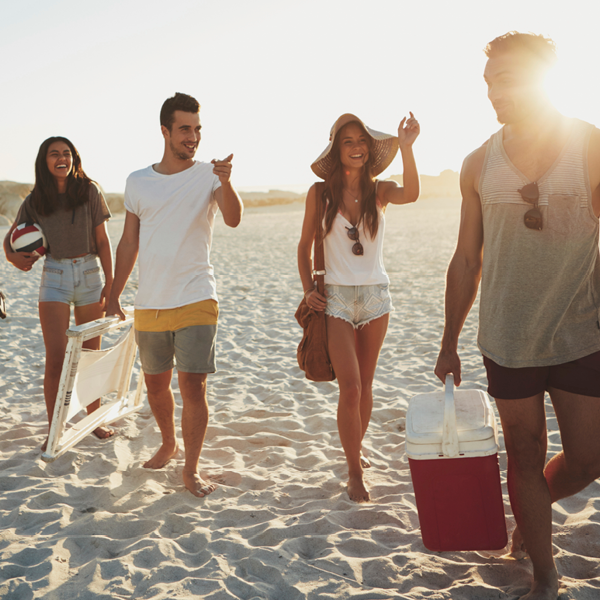This article was written by Robin Wielins, Au.D., a HearingLoss.com®-Certified provider located at Island Audiology & Hearing Aid Centers in Oahu, Kauai, and Kona, Hawai’i.
Hawai’i’s lush landscapes and ocean breezes offer an unmatched sensory experience — swaying palms, crashing surf, and melodic birdsong. But for those who rely on hearing aids, this tropical paradise comes with a hidden challenge: high humidity and salt air. While these environmental factors are part of what make the islands so special, they can also be tough on delicate hearing technology.
If you live in or are visiting Hawai’i and wear hearing aids, it’s important to understand how moisture buildup can affect device performance, how to spot the signs of water damage, and most importantly, how to protect your investment. In this guide, we’ll take a closer look at how Hawai’i’s environment interacts with hearing technology — and share practical ways to keep your devices working their best, no matter the weather.
Why Humidity and Salt Air Cause Hearing Aid Damage
Hearing aids are tiny marvels of engineering, packed with microphones, speakers, batteries, processors, and circuitry. Many are designed to be water-resistant to some degree, but they’re not waterproof — and they’re not impervious to long-term exposure to moisture or salt.
Humidity, present year-round in Hawai’i, increases the risk of condensation inside the device, especially in areas near the ear canal where sweat and body heat contribute to localized moisture. Over time, this can corrode metal components and interfere with electronic connections.
Salt air, carried by ocean breezes, contains microscopic particles of salt that can settle into device openings. Salt is corrosive and can damage microphones, battery terminals, and other metal parts, sometimes without immediate symptoms.
Sweat, especially during outdoor activities like hiking, paddling, or simply walking in the sun, is another contributing factor. Sweat contains both moisture and salt, making it a double threat to hearing technology.
Common Signs of Moisture Damage in Hearing Aids

Moisture-related issues may start subtly but can quickly worsen if not addressed. Some of the most common signs include:
- Muffled or distorted sound
- Intermittent functioning or frequent power loss
- Difficulty connecting to accessories or apps
- Corrosion or discoloration in the battery compartment
- Unusual static or feedback
- Failure to turn on, even with new batteries or a full charge
It’s easy to mistake these symptoms for a malfunction or aging device. In many cases, however, moisture or salt buildup is the real culprit — and with proper care, it can often be prevented or resolved.
Daily Hearing Aid Care Tips for Tropical Weather to Minimize Moisture Exposure
1. Wipe Your Devices Every Night
At the end of each day, use a clean, dry cloth to gently wipe down your hearing aids. Pay attention to microphone ports and the area around the battery door or charging contacts. This small habit removes surface moisture before it can seep inside.
2. Open the Battery Door or Remove the Rechargeable Device From the Charger
If your device uses disposable batteries, open the battery door at night to allow airflow. If your device is rechargeable, make sure it’s stored in a dry, well-ventilated space and not inside a steamy bathroom.
3. Avoid Direct Contact With Water
This includes removing your devices before showering, swimming, or using a sauna. Even brief exposure can allow moisture to find its way into the inner components.
4. Use a Hat or Headband During Outdoor Activities
This helps limit the amount of sweat that reaches your ears and devices, especially during hikes, workouts, or beach time.
Traveling Between Islands? Keep These Tips in Mind
Island-hopping is one of the best ways to experience the diversity of Hawai’i’s natural beauty — from the black-sand beaches of the Big Island to the lush valleys of Kauai. But frequent travel means your hearing aids are exposed to a variety of microclimates, not to mention changes in altitude, air-conditioning, and environmental moisture. Whether you’re taking a quick interisland flight or spending the night in a rainforest bungalow, it helps to plan ahead.
1. Use a Travel-Ready Storage Case
A durable, waterproof case with padding is a must for transporting your devices safely. Make sure your case seals tightly to keep out sand, humidity, or any accidental spills. If you use a charger or a drying system, consider packing a compact, travel-size version.
2. Bring Backup Supplies
Unexpected humidity or rain can cause issues midtrip. Carry extra batteries, domes, wax guards, or cleaning tools in your travel kit. If your hearing aids are rechargeable, ensure you have access to a power source — and don’t forget international adapters if you’re coming from outside the U.S.
3. Dry Before You Pack
Before placing your hearing aids in a case or charger for travel, make sure they’re dry. Trapping moisture inside a sealed case can accelerate corrosion. If your itinerary includes activities like boating, beach days, or forest hikes, allow your devices to air out for a few minutes before packing up.
4. Know Where to Get Help
If you’re staying on a different island for an extended time and need assistance, call ahead to Island Audiology. We can help assess your situation and provide recommendations, whether it’s a quick fix, a cleaning, or a full checkup. We’re committed to supporting you, no matter which island you’re on.

Traveling Somewhere Tropical? Plan Ahead for Your Hearing Care
Before you head to a humid, coastal, or tropical destination, connect with a certified hearing care provider near your location or travel spot. They can help prepare your devices, offer moisture-protection tips, and make sure you’re set for wherever island life takes you.
Hearing Aid Supplies to Have in Humid Climates

Daily care is important, but the Hawaiian climate often calls for extra protection. These tools can help you extend the life of your hearing aids and reduce the risk of weather-related damage.
1. Hearing Aid Dehumidifiers
There are two main types of hearing aid dryers: passive and active.
- Passive dehumidifiers use desiccant material to absorb moisture. They’re affordable and great for travel.
- Active dehumidifiers use gentle heat or air circulation to dry the device more thoroughly. Some models include UV lights to sanitize your hearing aids as well.
Regular use of a dehumidifier — especially overnight — can dramatically reduce internal moisture and protect sensitive electronics
2. Protective Covers or Sleeves
These soft, breathable sleeves wrap around your hearing aids and add a barrier against moisture, dust, and sweat. They don’t interfere with sound and are particularly useful for people who spend time outdoors, work up a sweat, or live close to the ocean.
3. Storage Considerations
When you’re not wearing your devices, keep them in a hard case or designated charging station — ideally in a dry, cool location. Avoid storing them near open windows, in humid bathrooms, or inside beach bags where they can collect sand and salt.
When to Seek Professional Help
If you notice performance issues and suspect water or salt damage, don’t wait for things to get worse. While some problems can be fixed at home with drying kits or cleaning tools, others may require professional attention.
At Island Audiology, we offer in-depth cleanings, moisture removal, and diagnostic checks that go beyond what at-home tools can do. Whether you’re dealing with minor corrosion or something more complex, our team can assess the damage and suggest a solution — often saving you from unnecessary replacements.

Need Help with Your Devices? Support Is Closer Than You Think
Whether you’re at home or on the go, certified hearing care is always within reach. Find a provider near you for expert cleanings, moisture checks, and personalized support — wherever you may be.
How Hawai’i’s Climate Shapes Device Choice
If you’re new to hearing aids or considering an upgrade, it’s worth discussing your lifestyle and environment with your audiologist. Some hearing aids come with advanced moisture resistance or water-repellent coatings. Others are designed with fewer openings, reducing the risk of salt and humidity exposure. Your audiologist can explain using the Ingress Protection (IP) ratings system. This system classifies the degree of protection an electronic device has against solids like dust and liquids like water. The rating consists of two numbers — the first indicating protection against solids (0–6) and the second against liquids (0–9), with higher numbers offering greater protection.
For active individuals, waterproof or water-resistant models may offer more peace of mind, especially if you enjoy kayaking, snorkeling (while devices are off and safely stored), or other coastal activities. Rechargeable options can also be beneficial, as they eliminate the need for battery doors — one of the most common entry points for moisture.
Your audiologist can help match you with a device that fits not only your hearing needs but your lifestyle in the islands.
Don’t Let the Climate Limit Your Lifestyle
Living in Hawai’i means embracing beauty, movement, and sound — waves crashing on the shore, birds calling through palm trees, music drifting on the breeze. Hearing aids help you stay connected to these moments.
Yes, the climate can be challenging. But with the right care and a little preparation, your devices can keep up with you.
Don’t let moisture hold you back from the full richness of island life. Instead, treat your hearing aids like any other important piece of gear: with care, attention, and expert guidance.
Questions? Island Audiology and HearingLoss.com Are Here to Help
As a hearing care provider living and working in Hawai’i, I know how deeply sound connects us — to each other, to nature, and to daily life on the islands. That’s why I founded Island Audiology: to help people fully experience every ocean breeze, every conversation, every note of music with clarity and confidence.
At our practice, we’re committed to the highest standards of care. We use real-ear measurement during fittings and follow-ups to ensure your hearing aids are precisely tuned for your individual hearing profile. This attention to detail often makes the difference between just “hearing better” and truly reconnecting with the world around you.
That’s also why I’m proud to be part of the HearingLoss.com network. Every provider in this trusted community shares the same dedication to evidence-based practices and patient-first care. By partnering with HearingLoss.com, I’m not just supporting my own patients — I’m part of a larger mission to make high-quality hearing care more accessible, informed, and empowering.
Whether you’re just beginning your hearing journey or looking for long-term support, I encourage you to explore the valuable tools and resources at HearingLoss.com. And if you’re in Hawai’i, my team and I at Island Audiology are here to help you hear — and live — your best island life.
Island Audiology & Hearing Aid Centers wants you to be satisfied with your care. We are a local, independent, community-oriented practice. Our services are fully guaranteed, meaning we’re committed to listening to your concerns, and your technology is always perfectly fit to renew your world of hearing. A strong patient-provider relationship based on honesty, integrity, and values is what we strive for, and we feel that this is the best approach to making sure you don’t miss any of the precious moments in your life.
References
- Ingress protection (IP) ratings guide. (2020). IEC. https://www.iec.ch/basecamp/ingress-protection-ip-ratings-guide


